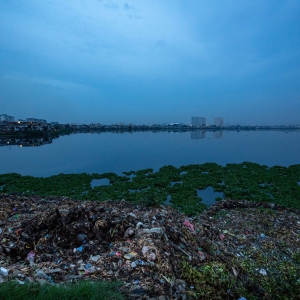Federal Water Tap, January 13: House Passes PFAS Bill
The Rundown
House bill includes controversial provisions that did not make it into a Defense spending bill last month. House Democrats outline climate legislation they plan to introduce later in January. The White House moves to change environmental review procedures. Fourteen climate and weather disasters last year caused more than $1 billion in damages in the U.S. The new North American trade deal, now moving through the Senate, includes $300 million for wastewater treatment infrastructure on the U.S.-Mexico border. The U.S. Geological Survey takes a more detailed look at water supplies in the upper Colorado River basin. And lastly, the EPA, missing a deadline, still has not said whether it will regulate certain PFAS chemicals in drinking water.
“What we need to give, as regulators, is certainty to the regulated community, so that if a project were not to go forward, they deserve a quick no. Right now, we string along so many people who are waiting decades for answers from the federal government. And again, that is not responsible governing.” — Elaine Chao, the secretary of transportation, speaking at a press conference about the administration’s proposed changes to federal environmental review.
By the Numbers
14: Number of climate and weather disasters in 2019 that caused more than $1 billion in damages. Last year was also the country’s second-wettest on record, behind 1973. Alaska sizzled, marking its hottest year on record, more than 6 degrees Fahrenheit above the long-term average. (NOAA)
$300 million: Funds authorized in the U.S.-Mexico-Canada trade deal for building wastewater treatment facilities along the U.S.-Mexico border. It’s been a problem recently. California’s attorney general and several local jurisdictions have filed federal lawsuits over sewage pollution in the Tijuana River. The House approved the trade deal in December and a Senate committee gave its endorsement this week. The trade deal also directs the U.S. representative to the North American Development Bank to make the financing of water treatment infrastructure a priority. (Congress)
News Briefs
PFAS Bill Passes House
The House approved wide-ranging legislation that would force government agencies to respond to PFAS contamination that has surfaced in hundreds of communities nationwide.
The PFAS Action Act would require the U.S. Environmental Protection Agency to set national drinking water limits for at least two PFAS chemicals: PFOA and PFOS. It also would require the agency to label the chemicals as hazardous substances under the federal Superfund act, which results in legal liability for cleanups.
The likelihood of the bill becoming law is slim. “It has no prospects in the Senate,” Sen. John Barrasso, a Wyoming Republican who heads the Environment and Public Works Committee, told Bloomberg Environment. “None.”
The White House issued a veto threat, arguing that the bill subverts the EPA’s expertise and raises costs for drinking water utilities.
“The regulatory process works best when EPA and other agencies are free to devise regulations based on the best available science and careful consideration of all the relevant facts,” the Trump administration’s advisers wrote. (Which is an ironic statement, given the pushback the administration has received for ignoring scientific evidence in numerous environmental rulemakings, including the proposed constriction of the Clean Water Act.)
Water utility groups oppose the bill on similar grounds, citing higher costs and legal liability for their members, which are not responsible for the contamination.
More PFAS Legislation
A bill introduced in the House seeks to strengthen oversight over the disposal of PFAS chemicals.
The PFAS Transparency Act would prohibit industrial facilities from sending such chemicals to wastewater treatment plants without first providing information to the plant operators about the substances being discharged.
The bill was included as an amendment to the PFAS Action Act, which passed the House last week.
Trump Administration Changes Environmental Review Procedures
In seeking to shorten federal environmental review, the Trump administration aims to limit the process to no more than two years.
The truncated timetable is one of the more significant changes that the White House proposes to make to the National Environmental Policy Act. The administration’s goal is to quicken the pace of permitting for roads, bridges, pipelines, mines, power plants, and other pieces of large hardware.
Public comments on the proposal are being accepted through March 10. Submit them via www.regulations.gov using docket number CEQ-2019-0003. Public hearings will be held on February 11, in Denver, and on February 25, in Washington, D.C.
Coal Waste Approval
The EPA approved Georgia’s application to take control of coal ash permitting and enforcement in the state.
A waste product from burning coal to generate electricity, coal ash is often stored in huge containments. When unlined, those containments are known to have polluted groundwater, rivers, and lakes with heavy metals.
A law that Congress passed in 2016 allowed the EPA to grant states the authority to oversee their own coal ash programs. In Georgia that duty now, with a few exceptions, falls to the state Environmental Protection Division.
Studies and Reports
Climate Change Legislation Outline
Democrats on the House Energy and Commerce Committee outlined climate change legislation that they plan to introduce later this month.
The CLEAN Future Act will establish a National Climate Bank to direct funding to communities most immediately in harm’s way.
The bill will provide funding to make drinking water systems more resilient to extreme weather. It requires polluting industries to be held accountable for toxic releases during storms. And it funds research into the health impacts of climate change.
Planning for Dam Emergencies
The Federal Emergency Management Agency published a report to help communities prepare plans for responding to dam failures.
On the Radar
Will the EPA Regulate PFAS in Drinking Water?
The first step in setting a federal limit for a drinking water contaminant is straightforward: the EPA has to say that it will do so.
We’re still waiting for the EPA to take that step. The agency sent its “regulatory determination” to the White House in early December for review. Andrew Wheeler, the EPA administrator, had aimed for a ruling by the end of 2019, but that deadline has passed without action.
The EPA press office would not explain the delay.
“EPA is continuing to work with OMB throughout the interagency review process for the proposed regulatory determination. Aggressively addressing PFAS will continue to be an EPA priority in 2020 and we will provide additional information on our upcoming actions as it becomes available,” Andrea Drinkard, a spokesperson, wrote in an email to Circle of Blue.
Monitoring Water Supplies in the Colorado River Basin
The U.S. Geological Survey is developing a more detailed system for assessing water supplies, and the upper Colorado River basin will be the second watershed in the country with enhanced monitoring.
Gathered from sensors and satellites, data on stream flows, evaporation, groundwater, snowpack, and soil moisture will be fed into computer models. The combination of observed and modeled output, employed already in the Delaware River basin, is expected to improve the accuracy of water-supply forecasts and illuminate the relationship between various parts of the water cycle, such as groundwater and streams.
Though the Colorado’s upper basin crosses multiple states, rivers within a single state — Colorado — will be assessed in this pilot. Those two rivers are the mainstem Colorado and its major tributary, the Gunnison.
Federal Water Tap is a weekly digest spotting trends in U.S. government water policy. To get more water news, follow Circle of Blue on Twitter and sign up for our newsletter.
Brett writes about agriculture, energy, infrastructure, and the politics and economics of water in the United States. He also writes the Federal Water Tap, Circle of Blue’s weekly digest of U.S. government water news. He is the winner of two Society of Environmental Journalists reporting awards, one of the top honors in American environmental journalism: first place for explanatory reporting for a series on septic system pollution in the United States(2016) and third place for beat reporting in a small market (2014). He received the Sierra Club’s Distinguished Service Award in 2018. Brett lives in Seattle, where he hikes the mountains and bakes pies. Contact Brett Walton





Leave a Reply
Want to join the discussion?Feel free to contribute!